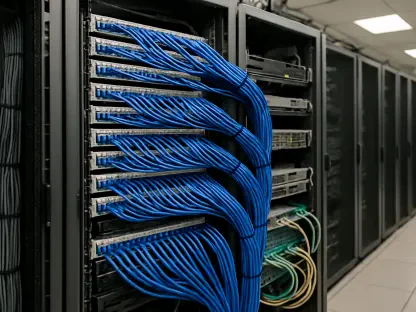I’m thrilled to sit down with Matilda Bailey, a renowned networking specialist with a deep focus on cutting-edge technologies like cellular, wireless, and next-gen solutions. With her finger on the pulse of data center infrastructure and innovation, Matilda offers invaluable insights into the rapid evolution of this critical industry. Today, we’ll dive into the driving forces behind the unprecedented demand for data centers, the challenges and opportunities in key North American regions, the role of energy solutions like nuclear power in supporting AI infrastructure, and the global trends shaping the future of digital connectivity.
Can you walk us through what’s fueling this massive surge in demand for new data centers across the globe?
Absolutely. The demand is largely driven by the explosion of data-intensive technologies, especially artificial intelligence and machine learning. These systems require immense computational power and storage, which data centers provide. Add to that the ongoing shift to cloud computing, the rise of IoT devices, and the need for low-latency networks with 5G, and you’ve got a perfect storm of need. It’s not just about quantity; it’s about speed and efficiency too—businesses and consumers expect instant access to data, pushing the industry to scale up rapidly.
How do you see the momentum of data center projects evolving over the next few years?
I think the pace will only accelerate, at least through the end of this decade. The appetite for digital services isn’t slowing down, and as more industries adopt AI and advanced analytics, the need for robust infrastructure will grow. We might see some regional saturation in places like Virginia, but emerging hubs in states like Pennsylvania or even countries like Vietnam are stepping up to fill the gaps. The challenge will be balancing this growth with sustainable energy solutions and regulatory frameworks.
What role are specific technologies like AI playing in pushing this expansion forward?
AI is arguably the biggest driver right now. It’s not just about running algorithms; it’s about training massive models that require hyperscale facilities packed with specialized hardware like GPUs. Projects like Amazon’s Project Rainier in Indiana, supporting AI models, show how much capacity is needed. Beyond AI, technologies like edge computing for real-time processing are also demanding smaller, localized data centers, creating a diverse landscape of infrastructure needs.
Focusing on North America, what are the key challenges Virginia’s ‘data center alley’ is facing in maintaining its dominance?
Virginia has been the epicenter for data centers for years, but it’s hitting some roadblocks. Power availability is a huge issue—there’s only so much grid capacity to go around, and AI workloads are incredibly energy-intensive. Land constraints and community pushback over environmental impacts are also slowing growth. It’s a classic case of success breeding its own challenges; the region’s popularity has stretched its resources thin.
How is Pennsylvania stepping up to rival established hubs like Virginia for AI data center projects?
Pennsylvania is making a bold play with its $70 billion initiative to attract investment. They’re focusing on building out infrastructure and energy capacity, which are critical for AI-driven projects. The state is offering incentives and leveraging its proximity to major markets while addressing power needs head-on. It’s a strategic move to position itself as a next-gen hub, especially as other regions face saturation.
Can you elaborate on Pennsylvania’s $70 billion plan and its potential economic impact?
This initiative, unveiled at the Pennsylvania Energy and Innovation Summit, is about transforming the state into a tech powerhouse. It includes funding for infrastructure upgrades, energy projects, and partnerships with major tech players. Economically, it could be a game-changer—think thousands of jobs in construction, tech, and support services, plus a ripple effect on local businesses. If executed well, it could redefine Pennsylvania’s role in the national economy, drawing in billions more in private investment.
Amazon’s $8 billion Project Rainier in Indiana is a standout. What makes this initiative unique among other hyperscaler projects?
Project Rainier is massive in scope—30 interconnected data centers spanning 200,000 square feet each, designed specifically for AI workloads like Anthropic’s Claude models. What sets it apart is the integration of specialized Trainium 2 servers and the sheer scale of investment. It’s not just about building capacity; it’s about creating a tailored ecosystem for cutting-edge AI, which could set a benchmark for future hyperscaler projects.
Meta’s GW-scale data center in El Paso, Texas, is slated for 2028. What hurdles might they face in meeting that timeline?
Scaling to a gigawatt facility is no small feat. Energy supply will be a major hurdle—Texas has a strained grid, and securing consistent, sustainable power for such a massive operation is tricky. Then there’s the construction timeline; labor shortages and supply chain delays could push things back. Environmental regulations and local opposition might also play a role, especially given the facility’s size and resource demands. It’s a tight window to pull off something this ambitious.
Turning to energy solutions, how viable do you think nuclear power is for meeting the rapid growth of AI infrastructure?
Nuclear power holds incredible promise for data centers, especially for AI’s voracious energy needs. It offers a stable, carbon-neutral source of power, which aligns with sustainability goals. However, the timeline is a concern—nuclear projects take years to develop, while AI infrastructure is scaling now. It’s a long-term solution, but we need interim strategies like battery storage or renewables to bridge the gap.
What are the major obstacles in scaling nuclear energy for data centers, based on current industry discussions?
The biggest obstacles are time and cost. Building nuclear facilities, even smaller modular reactors, requires significant upfront investment and regulatory approval, which can take a decade or more. Public perception and safety concerns also slow progress—there’s still hesitation around nuclear despite its reliability. Experts highlight that while the technology is ready, the infrastructure and political will to deploy it at scale are lagging behind the industry’s immediate needs.
Looking ahead, what is your forecast for the role of nuclear energy in powering the next generation of data centers?
I’m optimistic but realistic. Nuclear energy will likely become a cornerstone for data center power in the next 15 to 20 years, especially as projects like Texas Nuclear Ventures’ four reactors come online. It’ll be critical for meeting the baseload demands of hyperscale facilities. However, I expect a hybrid approach in the near term—combining nuclear with renewables and storage solutions to balance speed and sustainability. The industry is at a tipping point, and how we navigate these energy challenges will shape the future of digital infrastructure.









